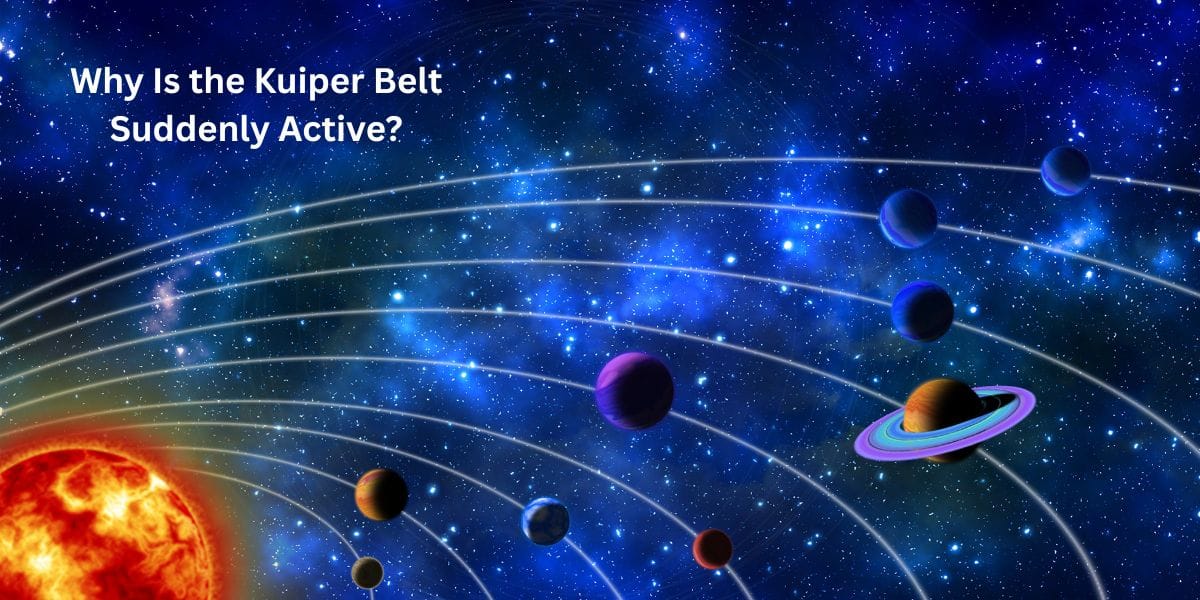Have you ever looked at the night sky and wondered what lies beyond Pluto? Far out in our solar system, there’s a mysterious region called the Kuiper Belt. It’s a ring of icy objects, including dwarf planets like Pluto, and it’s been quiet for a long time. But recently, scientists have noticed something strange—the Kuiper Belt is becoming more active!
What does this mean? Is something unusual happening out there? Scientists are excited because this could change what we know about our solar system. New comets, strange movements of objects, and even unknown forces might be at work.
So, why is the Kuiper Belt suddenly active? Let’s find out!
What Is the Kuiper Belt?
The Kuiper Belt is a huge, doughnut-shaped region beyond Neptune. It’s filled with icy rocks, comets, and dwarf planets. Think of it like a distant cousin of the asteroid belt, but much bigger and colder.
- Pluto is the most famous object in the Kuiper Belt.
- It’s home to thousands of other small worlds, like Haumea, Makemake, and Eris.
- Some comets, like Halley’s Comet, come from here.
Scientists study the Kuiper Belt to learn how our solar system formed. But now, something new is happening—objects there are moving in unexpected ways!
Why Are Scientists Talking About the Kuiper Belt Now?
For years, the Kuiper Belt was quiet. But in the last few years, telescopes have spotted more activity:
- New comets are appearing more often.
- Some objects are changing their orbits without a clear reason.
- A few dwarf planets are showing signs of surface changes, like cracks or geysers.
This sudden activity has scientists asking: Is something disturbing the Kuiper Belt?
Could Planet Nine Be Causing the Changes?
Some scientists believe an undiscovered planet, called Planet Nine, might be hiding in the outer solar system. If it exists, its gravity could be pulling Kuiper Belt objects in strange directions.
- Planet Nine (if real) could be 10 times bigger than Earth.
- Its gravity might explain why some objects move in odd paths.
- No one has seen it yet, but math suggests it could be there.
Until we find Planet Nine, this remains a mystery. But it’s a strong possibili
Are Comets Coming From the Kuiper Belt?
Yes! The Kuiper Belt is a major source of comets. When something pushes an icy object out of its orbit, it can fall toward the Sun, becoming a comet.
- Short-period comets (like Halley’s) come from the Kuiper Belt.
- The recent increase in comets might mean more objects are being disturbed.
- Scientists wonder if a nearby star or unseen planet is shaking things up.
Could a Passing Star Affect the Kuiper Belt?
Stars move through space, and sometimes one comes close to our solar system. Even a small nudge from a star’s gravity could send Kuiper Belt objects flying.
- A star named Scholz’s Star passed near us 70,000 years ago.
- Future close passes could disturb the Kuiper Belt again.
- Scientists check star movements to see if this is happening now.
Is the Sun’s Gravity Changing the Kuiper Belt?
The Sun’s gravity keeps the solar system together, but its pull weakens with distance. Some scientists think small changes in the Sun’s activity might affect the Kuiper Belt.
- Solar winds and flares could push tiny particles.
- Over millions of years, this might shift orbits slightly.
- But recent changes seem too fast for just the Sun’s influence.
What Do These Changes Mean for Earth?
Good news: Earth is safe! The Kuiper Belt is very far away, so its activity doesn’t threaten us. But studying it helps us understand:
- How comets form and move.
- If other hidden planets exist.
- How solar systems evolve over time.
A Solar System Mystery
The Kuiper Belt’s sudden activity is a big puzzle. Is it Planet Nine? A passing star? Or something else? Scientists are working hard to find answers.
One thing is clear—our solar system is more dynamic than we thought! Who knows what other surprises are waiting in the cold, dark edges of space?
📌 Frequently Asked Questions
What is the Kuiper Belt made of?
The Kuiper Belt is made of icy rocks, frozen gases, and dwarf planets like Pluto. It’s like a deep-freeze zone of the solar system.
How far is the Kuiper Belt from Earth?
The Kuiper Belt starts beyond Neptune, about 4.5 billion kilometers away. Its outer edge stretches much farther.
Is Pluto part of the Kuiper Belt?
Yes! Pluto is the largest known object in the Kuiper Belt. It’s classified as a dwarf planet.
Why is the Kuiper Belt important?
It helps scientists learn about the early solar system and where comets come from.
Can we see the Kuiper Belt from Earth?
Most objects are too small and far away, but powerful telescopes like Hubble and James Webb can spot some.
What is the difference between the Kuiper Belt and the Oort Cloud?
The Kuiper Belt is closer and shaped like a disk. The Oort Cloud is a distant, spherical shell of icy objects.
Could there be life in the Kuiper Belt?
It’s very unlikely because it’s too cold. But some moons (like Pluto’s Charon) have interesting features.
How many objects are in the Kuiper Belt?
Scientists estimate over 100,000 objects larger than 100 km exist there, with millions of smaller ones.
Will humans ever visit the Kuiper Belt?
Not soon—it’s too far. But robotic missions, like New Horizons, have flown by Pluto and other objects.
What is the biggest object in the Kuiper Belt?
Pluto is the largest known, but Eris is almost the same size. There could be even bigger objects waiting to be found!
